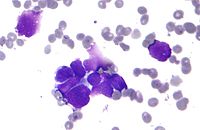
Photo from wikipedia
A 40-year-old male with a right-sided neck mass was diagnosed with metastatic melanoma. A repeat positron-emission tomography after treatment with combination immunotherapy demonstrated increased hypermetabolic activity in the right supraclavicular,… Click to show full abstract
A 40-year-old male with a right-sided neck mass was diagnosed with metastatic melanoma. A repeat positron-emission tomography after treatment with combination immunotherapy demonstrated increased hypermetabolic activity in the right supraclavicular, hilar, and mediastinal regions. Immunotherapy was discontinued and a BRAF/MEK inhibitor combination was started. Repeat imaging showed a decrease in size of the neck mass; however, hilar and mediastinal lymph nodes increased in size. A fine needle aspiration of mediastinal lymph nodes was consistent with a granulomatous process. A diagnosis of a sarcoid-like reaction (SLR) was made, and he was started on steroids. A follow-up positron emission tomography showed decreased hilar and mediastinal lymph node hypermetabolic activity. We, therefore, report this rare case of immunotherapy-induced SLR to the expanding literature on immunotherapy-related adverse effects and would like to highlight that SLR can occur in conjunction with disease progression making it challenging to distinguish between the two.
Journal Title: Journal of Investigative Medicine High Impact Case Reports
Year Published: 2021
Link to full text (if available)
Share on Social Media: Sign Up to like & get
recommendations!